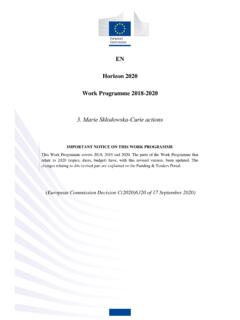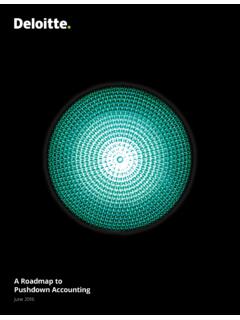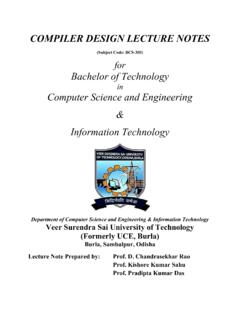Transcription of 5. Noise Management - World Health Organization
1 665. Noise ManagementThe goal of Noise Management is to maintain low Noise exposures, such that human Health andwell-being are protected. The specific objectives of Noise Management are to develop criteria forthe maximum safe Noise exposure levels, and to promote Noise assessment and control as part ofenvironmental Health programmes. This is not always achieved (Jansen 1998). The UnitedNations Agenda 21 (UNCED 1992), as well as the European Charter on Transport, Environmentand Health (London Charter 1999), both support a number of environmental managementprinciples on which government policies, including Noise Management policies, can be include:a.
2 The precautionary principle. In all cases, Noise should be reduced to the lowestlevel achievable in a particular situation. Where there is a reasonable possibility thatpublic Health will be damaged, action should be taken to protect public Health withoutawaiting full scientific The polluter pays principle. The full costs associated with Noise pollution(including monitoring, Management , lowering levels and supervision) should be metby those responsible for the source of The prevention principle. Action should be taken where possible to reduce Noise atthe source.
3 Land-use planning should be guided by an environmental Health impactassessment that considers Noise as well as other government policy framework is the basis of Noise Management . Without an adequatepolicy framework and adequate legislation it is difficult to maintain an active or successful noisemanagement programme. A policy framework refers to transport, energy, planning,development and environmental policies. The goals are more readily achieved if theinterconnected government policies are compatible, and if issues which cross different areas ofgovernment policy are Stages in Noise ManagementA legal framework is needed to provide a context for Noise Management (Finegold 1998; Hede1998a).
4 While there are many possible models, an example of one is given in Figure Thismodel depicts the six stages in the process for developing and implementing policies forcommunity Noise Management . For each policy stage, there are groups of policy players whoideally would participate in the A model of the policy process for community Noise Management (Hede 1998a)When goals and policies have been developed, the next stage is the development of the strategyor plan. Figure summarizes the stages involved in the development of a Noise managementstrategy.
5 Specific abatement measures 19 are listed in Table Agenda Setting( Noise Problem Identification)2. Problem Analysis( Noise Impact Assessment)3. Policy Formulation( Noise Control Options)5. Implementation(Operation of Noise Regulation)6. Policy Evaluation(Evaluation of Noise Regulation)POLICY STAGESPOLICY PLAYER GROUPS* Technology officials * Acoustics Professionals* Researchers * Community * Interest Groups* Technology officials * Acoustics Professionals * Community * Interest Groups* Politicians * Political Advisers *Politicians*Political Advisers*Technology officials* Policy Analysts * Community * Researchers * Interest Groups * Acoustics Professionals 4.
6 Policy Adoption(Decision on Noise Regulation)Policy Revision* Technology officials * Policy Analysts* Researchers * Acoustics Professionals* Community * Interest Groups*Politicians*Political Advisers*Technology officials* Policy Analysts * Community * Researchers * Interest Groups * Acoustics Professionals 1. Agenda Setting( Noise Problem Identification)2. Problem Analysis( Noise Impact Assessment)3. Policy Formulation( Noise Control Options)5. Implementation(Operation of Noise Regulation)6. Policy Evaluation(Evaluation of Noise Regulation)POLICY STAGESPOLICY PLAYER GROUPS* Technology officials * Acoustics Professionals* Researchers * Community * Interest Groups* Technology officials * Acoustics Professionals * Community * Interest Groups* Politicians * Political Advisers *Politicians*Political Advisers*Technology officials* Policy Analysts * Community * Researchers * Interest Groups * Acoustics Professionals 4.
7 Policy Adoption(Decision on Noise Regulation)Policy Revision* Technology officials * Policy Analysts* Researchers * Acoustics Professionals* Community * Interest Groups*Politicians*Political Advisers*Technology officials* Policy Analysts * Community * Researchers * Interest Groups * Acoustics Professionals 68 Figure Stages involved in the development of a Noise abatement MitigationTransmissionNoise SourceNoise Management Strategy(See Table ) Noise ExposureCostsInfrastructure& BehaviouralChangesCosts & BenefitsHealth Effects69 Table Recommended Noise Management Measures (following EEA 1995)Legal measuresExamplesControl of Noise emissionsEmission standards for road and off-roadvehicles; emission standards for constructionequipment; emission standards for plants.
8 National regulations, EU DirectivesControl of Noise transmissionRegulations on sound-obstructive measuresNoise mapping and zoning around roads,airports, industriesInitiation of monitoring and modelingprogrammesControl of Noise immissionsLimits for exposure levels such as nationalimmission standards; Noise monitoring andmodeling; regulations for complex noisesituations; regulations for recreational noiseSpeed limitsResidential areas; hospitalsEnforcement of regulationsLow Noise Implementation PlanMinimum requirements for acousticalproperties of buildingsConstruction codes for sound insulation ofbuilding partsEngineering MeasuresEmission reduction by source modificationTyre profiles; low- Noise road surfaces; changesin engine propertiesNew engine technologyRoad vehicles; aircraft; construction machinesTransmission reductionEnclosures around machinery; Noise screensOrientation of buildingsDesign and structuring of tranquille uses; usingbuildings for screening purposesTraffic managementSpeed limits.
9 Guidance of traffic flow byelectronic meansPassive protectionEar plugs; ear muffs; insulation of dwellings;fa ade designImplementation of land-use planningMinimum distance between industrial, busyroads and residential areas; location oftranquillity areas; by-pass roads for heavytraffic; separating out incompatible functonsEducation and informationRaising public awarenessInforming the public on the Health impacts ofnoise, enforcement action taken, Noise levels,complaintsMonitoring and modeling of soundscapesPublication of resultsSufficient number of Noise expertsUniversity or highschool curriculaInitiation of research and developmentFunding of information generation accordingto scientific research needsInitiation of behaviour changesSpeed reduction when driving; use of horns.
10 Use of loudspeakers for advertisements70 The process outlined in Figure can start with the development of Noise standards orguidelines. Ideally, it should also involve the identification and mapping of Noise sources andexposed communities. Meteorological conditions and Noise levels would also normally bemonitored. These data can be used to validate the output of models that estimate Noise standards and model outputs may be considered in devising Noise control tactics aimed atachieving the Noise standards. Before being enforced, current control tactics need to be revised,and if the standards are achieved they need continued enforcement.














